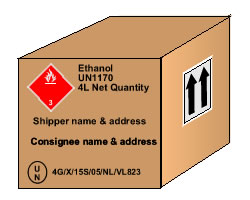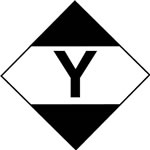MODULE 7 || Marking & Labelling for Dangerous Good Packaging
As the previous modules have explained, when shippers pack and send dangerous goods cargo, they have very specific responsibilities in regard to classification and packaging. Shippers are also responsible for making sure that the cargo is correctly marked and labelled.
Generally speaking, the marks and labels will:
- Clearly indicate the nature of the packages' contents, including the type of hazard the contents may pose;
- Indicate how to handle and stow the package safely; and
- Show that the appropriate packaging has been used for the type and quantity of dangerous goods contained within it.
In this module, we look at what the shipper's responsibilities are when marking and labelling packages containing dangerous goods.
Marking and Labelling
The minimum marking and labelling that must appear on a package of dangerous goods is:
- Proper Shipping Name
- UN or ID Number mark and the letters "UN" or "ID" preceding the Number as appropriate, at least 12 mm high (except where specified differently under 7.1.4.4 of the current IATA DGR)
- Net/Gross weight of substance/package as applicable
- Full name and address of the shipper and consignee
- Class or Division Label and sub-risk label if applicable
- Orientation labels ("This Way Up" labels) on 2 opposite sides of the package, if contents are liquid dangerous goods
- UN specification codes if using a UN package instruction (see below example) OR the Limited Quantity mark/label if the package is not UN packaging.
The following pictures illustrate the minimum marks and labels required for both UN packaging and Limited Quantity packaging.
Example: UN packaging marks and labels
(Note: the graphic further down this page will more fully explain the various components of the UN specification code mark).
| UN Specification Packaging Code Mark Example | UN Package marks and labels |
|
|
 |
Example: Limited Quantity packaging marks and labels
The Limited Quantity mark must be used when sending dangerous goods in limited quantities.
Please note: the Limited Quantity mark must be applied on one face of the package. If the mark is applied by means of a label, the label must not be folded or applied in a way that makes it appear on different faces of the package - it must be wholly on one face of the package.
| Limited Quantity Mark | Limited Quantity Package marks and labels |
|
|
 |
Please Note: As you can see in the two examples above, the following marking and labelling must be applied on the same side of the package when the packing size is adequate:
- The proper shipping name
- UN or ID Number
- Shipper & Consignee details
UN Specification Marking
You may remember from module 6 that UN specification packaging has been performance tested to ensure the package will withstand normal conditions of air transport. This type of packaging bears the appropriate UN Specification Marking, indicating the type of performance testing carried out upon the package. The markings are different depending on package type and testing criteria they have been tested to. The following is an example of such marking.
Limited Quantity Package Marking
In module 6, we also discussed how it is possible to send smaller quantities of some dangerous goods via Limited Quantity packaging instead of UN specification packaging. We spoke about how Limited Quantity packaging does not undergo the same quality control as UN specification packaging. Therefore, if you are sending material using Limited Quantity packaging, the outer package will not have UN specification markings. Instead, it will require a diamond-shaped Limited Quantity label/mark as shown in the graphic below.


